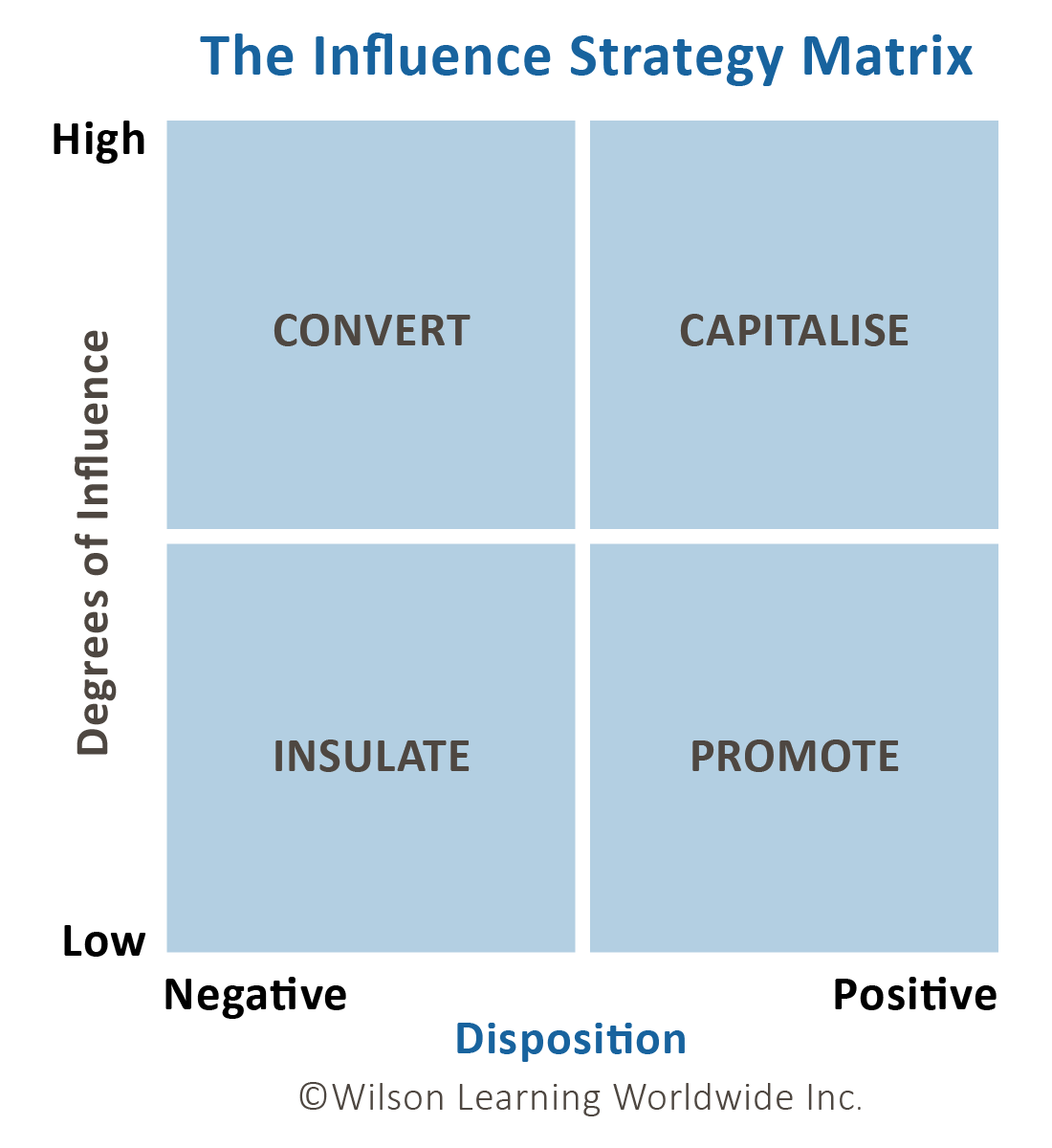Competitive sales strategy
Influencing the decision to win the sale

How does a done deal come undone? Your rep had a good relationship with a great contact, the right solution to meet the customer's needs, and strong buying signals right up to the last meeting. Then came the dreaded call: "Thank you for the proposal, but we've decided to go with someone else." So, what happened? Could this loss have been prevented?
In our experience of looking at thousands of win-loss reviews and talking to salespeople and sales managers, in many cases, the salesperson did not have a full picture of how the decision was being made, who was influencing the final decision and what these influencers thought of your salesperson.
Equipping your salespeople with the right skills will ensure this kind of thing never happens to your team again. There are three important contributors to sales success: learning as much as possible about the customer's decision process, ascertaining who is involved and determining their level of influence.
In the business-to-business world, buying decisions have grown more complex. Multiple departments and multiple people are often involved, and frequently one person can say "yes," but many people can say "no." Often, a complex decision and/or one requiring a large investment will require a lengthy decision process with multiple steps and hurdles to jump over, then at the end, procurement steps in with more obstacles.
To understand and anticipate the decision process as well as recognise the players involved, means establishing long-term relationships with a range of people who can provide information and answers to key questions. The payoff is to build a foundation of knowledge for an effective competitive strategy.
KNOW THE PROCESS
To get the full picture needed to stay ahead in a competitive situation, it is critical to discover the "what," "why" and "who" of the decision. That means finding out what steps will be taken in making the decision, who the decision makers are and, most importantly, what buying criteria will determine the final decision. The decision process will vary from company to company and will depend on the situation. Complex solutions and higher costs will drive a more complex decision process with more steps and more people involved.
Examine the decision process based on who is involved. Learn who will be affected by the solution and who has the funding authority. If many people have a stake in the decision, there might be a buying committee and/or a screening committee to narrow the number of potential suppliers—the funder may be a key executive with final say on the purchase. That person's interests and position might drive a narrower process with fewer people involved. The ability to block competitors begins with understanding what process is being followed.
KNOW THE CRITERIA
The question of buying criteria is complicated by the fact that there may be "official" criteria and requirements that are shared with all competing suppliers. The smart salesperson will dig beneath the surface to identify the particular issues and concerns of each decision maker. IT people may be concerned with criteria such as technological performance and installation, users may be focused on how easy it is to learn and finance managers will be measuring value by financial criteria such as ROI.
Different emphases on different buying criteria are not the only factors that vary with individual decision makers. To protect against a competitor requires in-depth knowledge of each individual's role, level of influence and disposition toward the seller.
In our experience, a large number of surprise losses are due to salespeople not having accurate answers to three critical questions:
- Who has a stake in the decision and could influence the outcome?
- Who has the most influence over the final decision maker (or decision makers)?
- How does each person view me and my competitors?
It can be tricky to determine who is really involved in the decision, especially if a familiar contact claims to be the key decision maker. Most salespeople are hesitant to "go behind the back" of a contact, yet it is crucial to know who the real players are, as well as their roles and weight in the process. The best way to get this information is to ask the closest contact for help in identifying the other decision makers and influencers, then ask questions to learn:
- Whose budget is funding this purchase? Who will need to sign off on the financial aspects?
- Are there people in the organisation with specialised expertise or technical knowledge who will help make the decision?
- Whose job will this affect?
- Is there anyone else who cares about the outcome of this decision?
Once these questions are answered, the salesperson can build relationships with others who may be directly involved in the decision—who can tell who is directly involved and who has the most influence on the final decision.
Who has influence on the decision, and what kind of influence?

Once the criteria for the purchase are determined, and key players have been identified and their official roles in the process confirmed, it's important to dive deeper. The salesperson needs to find out who is truly influential and what each key decision maker thinks of your organisation and the competition. Questions should be asked to identify both "official influence" that attaches to position in the company and official role in the decision-making process. It's also of high value to cultivate insiders who can share information about more subtle types of influence—the kind that comes from reputation, expertise, personal relationships and so forth. A strongly influential individual's opinion may carry even more weight than a higher ranking manager or executive. One of those surprises we are trying to avoid may occur if the salesperson misses this influencer in creating his or her strategy.
What do the decision makers think of me?
Once the stakeholders and their sources and levels of influence have been identified, the salesperson needs one more piece of information: does someone in the buying organisation favour a competitor? It is not unusual for a salesperson to understand the decision process and who is involved, but not realise there is someone with a lot of influence who is affiliated with or advocating for a competitor. This can be a serious barrier to winning a sale. Everyone has a story about a customer who has a previous relationship with a particular vendor or a key stakeholder who has some reason to be against a vendor, possibly because of a bad experience. There are also personal and political alliances that can derail a well-planned proposal.
Again, salespeople must make good use of a variety of contacts and ask the right questions to discover hidden agendas, circles of influence and the favourable or unfavourable biases of decision makers.
The Influence Strategy Matrix is a helpful tool for organising strategy for "influencing the influencers." For each key decision maker, the degree of influence—high, medium or low—is established. Then each individual's disposition or bias for or against the salesperson is determined.
Depending on the level of influence and the disposition, a strategic influence plan can be formulated: For buyers who are highly influential and positively disposed, the salesperson can Capitalise on their influence in the organisation. For a buyer who is positively disposed but not as influential, the salesperson can work to Promote the individual in conversations with others, inviting participation in meetings and so forth. If an individual is negatively disposed but has high influence, the salesperson can try to Convert the person to a more favourable position. A person who has lower influence and is negatively disposed can possibly be isolated from other decision makers to try to limit potential damage.
Whatever the influence strategy, the most important thing to ensure success is to know everything possible about the players in the decision process—their roles, their influence and their perspective. If the salesperson chooses to stay in the familiar circle of contacts, there's a much higher likelihood of missing key information and opening the door to a competitor.
To learn more, contact Wilson Learning Worldwide | Phone: +44.1494.678.121 | Email: info@wilsonlearning.co.uk









 Please complete this form to download Competitive sales strategy | Influencing the decision to win the sale.
Please complete this form to download Competitive sales strategy | Influencing the decision to win the sale.



